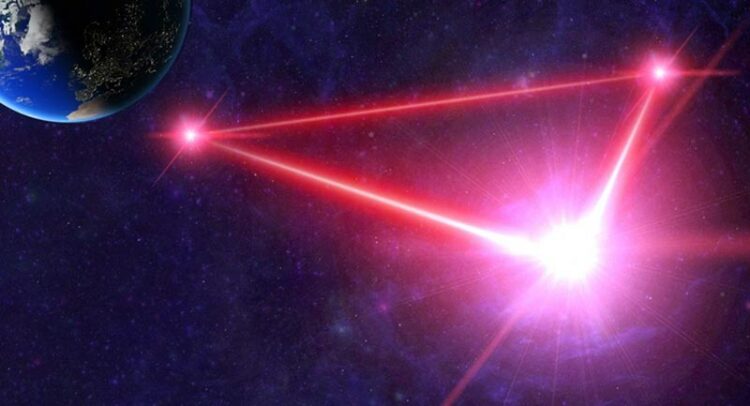The search for the missing gravitational signal

LISA - Laser Interferometer Space Antenna
Credit: Simon Barke - University of Florida
A new SISSA study proposes an array of interferometers in space to detect subtle fluctuations in the background gravitational signals that may reveal the secrets of black hole mergers.
Every year, hundreds of thousands of pairs of black holes merge in a cosmic dance that emits gravitational waves in every direction. Since 2015, the large ground-based LIGO, Virgo and KAGRA interferometers have made it possible to detect these signals, although only about a hundred such events, an infinitesimal fraction of the total, have been observed.
Most of the waves remain ‘indistinguishable’, superimposed and added together, creating a flat, diffuse background signal that scientists call the ‘stochastic gravitational wave background’ (SGWB). New SISSA research, published in The Astrophysical Journal, proposes using a constellation of three or four space interferometers to map the flat and almost perfectly homogeneous background in a search for ripples. These small fluctuations, known to scientists as anisotropies, hold the information needed to understand the distribution of gravitational wave sources on the largest cosmological scale.
Researchers are convinced that next-generation detectors, such as the Einstein Telescope and the Laser Interferometer Space Antenna (LISA), will make direct measurement of the gravitational wave background possible in the foreseeable future. “Measuring these background fluctuations, known more correctly as anisotropies, will however continue to be extremely difficult, as identifying them requires a very high level of angular resolution not possessed by current and next generation survey instruments”, explains Giulia Capurri, a SISSA PhD student and first author of the study.
Capurri, supervised by Carlo Baccigalupi and Andrea Lapi, has suggested that this problem could be overcome by means of a ‘constellation’ of three or four space interferometers in solar orbit and covering a distance approximating that between Earth and the Sun. With increasing separation, interferometers achieve better angular resolution, improving their ability to distinguish sources of gravitational waves. “A constellation of space interferometers orbiting the Sun could enable us to see subtle fluctuations in the gravitational background signal, thus allowing us to extract valuable information about the distribution of black holes, neutron stars and all other sources of gravitational waves in the universe” states Capurri.
Following the success of the LISA project’s space mission test, there are currently two proposals for the creation of space-based interferometer constellations: one European – the Big Bang Observatory (BBO), and one Japanese – the Deci-hertz Interferometer Gravitational-wave Observatory (DECIGO). “This represents one of the earliest work to provide specific predictions of the size of the stochastic background of gravitational waves by a constellation of instruments orbiting the Sun. Together with further similar projects whose details will be published in due course, they will be crucial for developing an optimal design for future observational instruments that we hope will be built and commissioned in the coming decades” concludes Carlo Baccigalupi, professor of theoretical cosmology at SISSA.
In the era of multimessenger astronomy, which began with ground-based interferometers such as LIGO and Virgo, the gravitational-wave background could pave the way to a new understanding of the universe on the large scale, as has already happened with the cosmic microwave background.
Journal: The Astrophysical Journal
DOI: 10.3847/1538-4357/acaaa3
Method of Research: Case study
Subject of Research: Not applicable
Article Title: Searching for Anisotropic Stochastic Gravitational-wave Backgrounds with Constellations of Space-based Interferometers
Article Publication Date: 27-Jan-2023
Media Contact
Francesca de Ruvo
Scuola Internazionale Superiore di Studi Avanzati
fderuvo@sissa.it
Cell: 3297453567
Original Source
All latest news from the category: Physics and Astronomy
This area deals with the fundamental laws and building blocks of nature and how they interact, the properties and the behavior of matter, and research into space and time and their structures.
innovations-report provides in-depth reports and articles on subjects such as astrophysics, laser technologies, nuclear, quantum, particle and solid-state physics, nanotechnologies, planetary research and findings (Mars, Venus) and developments related to the Hubble Telescope.
Newest articles

NASA: Mystery of life’s handedness deepens
The mystery of why life uses molecules with specific orientations has deepened with a NASA-funded discovery that RNA — a key molecule thought to have potentially held the instructions for…

What are the effects of historic lithium mining on water quality?
Study reveals low levels of common contaminants but high levels of other elements in waters associated with an abandoned lithium mine. Lithium ore and mining waste from a historic lithium…

Quantum-inspired design boosts efficiency of heat-to-electricity conversion
Rice engineers take unconventional route to improving thermophotovoltaic systems. Researchers at Rice University have found a new way to improve a key element of thermophotovoltaic (TPV) systems, which convert heat…



